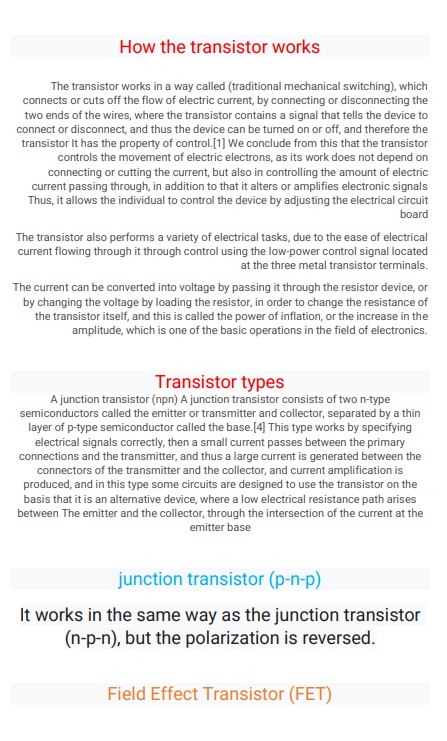What is a Transistor
Summary:
The transistor works in a way called (traditional mechanical switching), which connects or cuts off the flow of electric current, by connecting or disconnecting the two ends of the wires, where the transistor contains a signal that tells the device to connect or disconnect, and thus the device can be turned on or off, and therefore the transistor It has the property of the control.[1] We conclude from this that the transistor controls the movement of electric electrons, as its work does not depend on connecting or cutting the current, but also controlling the amount of electric current passing through; in addition to that, it alters or amplifies electronic signals. Thus, it allows the individual to control the device by adjusting the electrical circuit board.
The transistor also performs a variety of electrical tasks, due to the ease of electrical current flowing through it through control using the low-power control signal located at the three metal transistor terminals. The current can be converted into voltage by passing it through the resistor device, or by changing the voltage by loading the resistor, to change the resistance of the transistor itself, and this is called the power of inflation, or the increase in the amplitude, which is one of the basic operations in the field of electronics.
Excerpt:
What is a Transistor
How the transistor works
The transistor works in a way called (traditional mechanical switching), which connects or cuts off the flow of electric current, by connecting or disconnecting the two ends of the wires, where the transistor contains a signal that tells the device to connect or disconnect, and thus the device can be turned on or off, and therefore the transistor It has the property of a control.[1] We conclude from this that the transistor controls the movement of electric electrons, as its work does not depend on connecting or cutting the current, but also on controlling the amount of electric current passing through. In addition to that, it alters or amplifies electronic signals. Thus, it allows the individual to control the device by adjusting the electrical circuit board.


Reviews